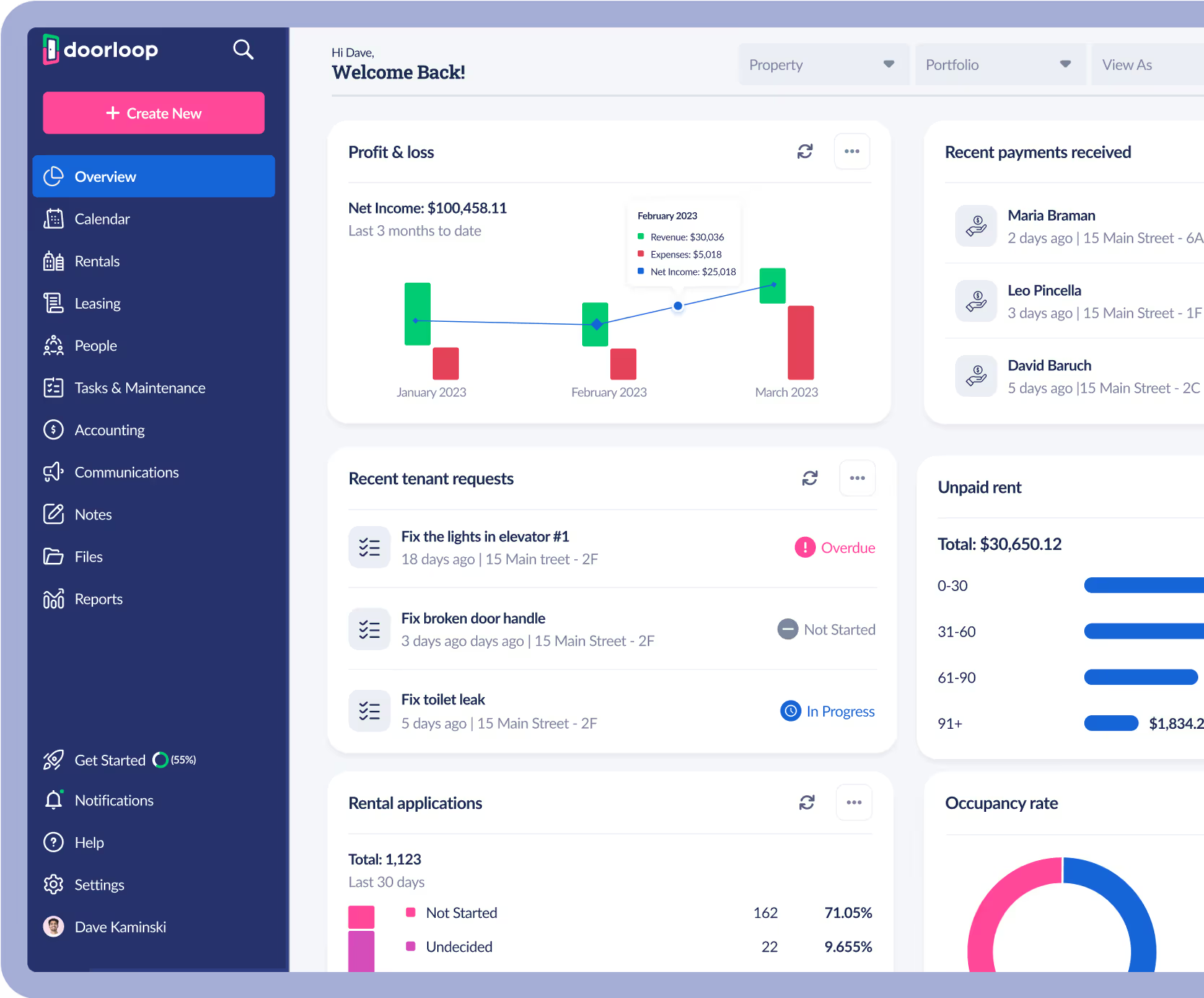Landlords in Oregon know that they require a rental contract to explain to the potential tenant what they should expect over the course of a lease term. Generally, the lease agreements lay out rules and expectations, giving everyone a better experience.
Therefore, the lease protects your best interest and tells prospects what they must know. That means they choose whether or not to accept your terms.
You should ensure you've included all the information needed, such as security deposits, rent, recurring fees, termination terms, and more.
This page outlines everything that should be included in an Oregon lease agreement. Plus, you'll see tips about making things easier with property management software.
Oregon Contracts
An Oregon lease agreement is a contract signed by the landlord and tenant. It documents the rules associated with the property and includes monthly rent payments, the security deposit, and other crucial factors.
Typically, an Oregon commercial lease agreement is similar, though it focuses on business tenants who don't live on the premises.
What to Include
Here's what to include in the agreement:
Rent
Rent should be paid at the place and time agreed upon by both parties. The landlord can charge late fees after a four-day grace period. There are no rules in place on the sum allowed for a late fee.
Security Deposit
State law doesn't specify a security deposits maximum that Oregon landlords may charge. However, before altering the security deposit amount, the landlord must give a three-months notice.
The security deposit must be returned to the tenant thirty-one days after the tenancy ends. If any money was removed to cover damages, an itemized list must be included.
Lease Termination and Evictions
The lease should provide information about evictions. Reasons to evict can include:
- Failure to pay rent
- Violation of the lease that causes issues with the other tenants' enjoyment
- Conducting illegal activities
- Providing false information
- Damages by pets
Landlord's Right to Enter
The lease should provide the right to entry information. Generally, landlords don't have to provide notice during emergencies.
However, they must give the tenant a twenty-four-hour notice before entering in other situations.
Build Your Own
Mandatory Disclosure
Oregon law indicates that each rental agreement has these required disclosures in the lease for the tenant, though a move-in checklist isn't necessary:
- Landlord's Name/Address - The lease should contain contact information about the person authorized to handle notices and demands between the landlord and tenant.
- Flood Plain - If rentals are in the 100-year flood plain, the landlord must disclose flooding risks. This is determined by the Federal Emergency Management Agency through the National Flood Insurance program. The tenant agrees to accept tenancy risk when signing the agreement.
- Carbon Monoxide Alarm - This disclosure is required for any rental unit with a carbon monoxide source. Landlords can't enter into rental agreements with the tenant if the property doesn't have a functioning alarm system installed. The lease must include written instructions for testing, battery replacement as needed, and disclosures stating that the tenant is responsible for maintaining the unit.
- Pending Suits - If the landlord has a housing unit with four or fewer units, they must inform the tenant of these pending suits or outstanding notices within the agreement: (1) Pending proceeding to foreclose on a tax lien, (2) Pending suit to foreclose on a trust deed, mortgage, or vendor's lien under the contract of sale, (3) Outstanding notice of default under the contract of sale, mortgage, trust deed, or notice of a trustee's sale under the trust deed, (4) Pending declaration of suit or forfeiture for a specific performance of the contract of sale, trustees' sale, or vendors' lien
- Common Area Utilities - Properties that share utility meters in common areas or between multiple units should disclose that in the agreement. Landlords should specify the utilities shared and how, along with compensation for tenant payment.
- Smoking Policy - Landlords in Oregon have to disclose if smoking is allowed in the rental. If only allowed in some areas, it must state where they are.
- Recycling - Oregon properties housing five+ dwellings are multifamily. If that's the case, landlords have to provide multifamily recycling services to the tenant if it's in an urban growth boundary of the city. Landlords must provide separate containers for all recyclables. They should be taken for collection to the service. The tenant must receive a notice about the chance to recycle and how to do so.
- Security Deposit Receipt - Rental agreements must contain the financial institution's name and address where the person's security deposit was placed and whether it's in an interest-bearing account. Receipts are required for the tenant within two weeks once the landlord received it.
- Lead-based Paint - Federal law demands that homes built before 1978 offer disclosures about lead-based paint risks. Landlords must fill out the form and attach it to the agreement. They must also give the tenant an approved pamphlet explaining the dangers.
Why DoorLoop?
Whether you need a rental application, an Oregon sublease or room rental agreement that explains what the original tenant and new one must do, or lease agreements to keep on hand, property management software is crucial. Most people think they need licensed attorneys, but DoorLoop can help them do everything they require.
Auto-fill your templates and customized agreements quickly so that you can send them to potential tenants. Plus, DoorLoop offers tenant screening with one click, allowing you to handpick people for the property.
Fill out the free form on the DoorLoop website to get started with a demo!
eSignature
Having an efficient lease signing process in place is crucial for making tenant onboarding easier and more efficient.
With DoorLoop, you can easily have your leases eSigned by tenants, as well as create reusable lease templates that are autofilled with tenants' information so that you can do in seconds what used to take hours.
DoorLoop also makes it super easy to find great new tenants in the first place by syndicating your lisitngs on popular websites Zillow, Trulia, Hotpads, Apartments.com, and more. You can also find the very best tenants by screening your prospects in seconds through DoorLoop. The best part is that paper applications and leases are a thing of the past! Your tenants can fill out their rental application online and be screened (and selected!) in seconds.
For more information about DoorLoop, learn more or schedule a free demo.
Conclusion
Most people feel they have to hire licensed attorneys to craft a rental agreement. While that's possible, it's rarely cost-effective and can take time.
The first step is learning what to include in the Oregon lease, which you did above. Now, you should focus on property management software like DoorLoop. Test it out to see what it can do for you.
FAQs
How long should the Oregon lease agreement be?
A rental agreement can have a maximum lease term of one year. While it can be longer, these are rare. Still, all leases can be verbally agreed to and not written.
Is an Oregon lease agreement binding?
Yes, a rental arrangement between a landlord and tenant is legally binding, whether it's oral or written. This means it's enforceable as long as both parties agree.
Can a residential lease agreement automatically renew?
Yes, a residential lease can automatically renew, as long as the landlord approves. Notice is required by the tenant if they don't want to renew. Generally, a renewal clause is included in the contract, but this isn't always necessary, especially for oral agreements.




















.svg)
.svg)